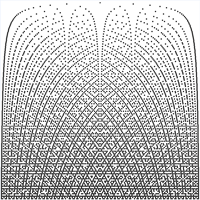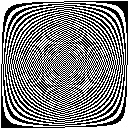A φ Fractal
 I’ve been examining the visual patterns produced by the Whitney Music Box (see previous post). If you watch the animation for any length of time, you’ll notice that the dots form spoked or starfish-like patterns periodically. These patterns often cause chords to be played by the music box.
I’ve been examining the visual patterns produced by the Whitney Music Box (see previous post). If you watch the animation for any length of time, you’ll notice that the dots form spoked or starfish-like patterns periodically. These patterns often cause chords to be played by the music box.
I was curious to understand the sequence of N-armed patterns. I noticed a sequence in which the number of arms descended 11,10,9,8,7,6,5,4,3,2 (with 2 in the exact middle of the 3 minute cycle). But these patterns were interspersed with another sequence that went 11,9,7,5 and I detected some other sequences interspersed as well.
Paying attention to the position of the largest dot (which travels around the circle only once during the 3 minute cycle), I realized that the spoked formations can be predicted by the position of that dot. The position of the dot can be represented as a fraction, which represents how much of the cycle it has completed.
- When the position is 1/2, we see a 2-spoked pattern.
- When the position is 1/3, or 2/3 we see a 3-spoked pattern,
- When the position is 1/4, or 3/4 we see a 4-spoked pattern.
- When the position is 1/5, 2/5, 3/5 or 4/5 we see a 5-spoked pattern.
This makes sense given that the orbits of all the smaller dots are multiples of the largest dot. So when the largest dot is at N/5, the smallest dots must be at N*M/5 – so all the dots must be at a point which divides the circle into 5.
More generally, the number of spokes will always be the denominator of the lowest-common denominator fraction which represents the position of the largest dot. For example, when the dot is at position 3/9, it is also at 1/3, so we see only a 3-spoke pattern. So for the 9s, only the fractions for which the numerator and denominator are relatively prime will we see a 9-spoked pattern: 1/9, 2/9, 4/9, 5/9, 7/9, 8/9.
For each division of the cycle n, I plotted the positions in the cycle in which an n-armed spoke pattern will be seen, and produced the above graphic (here is a larger version).
The image is a fractal, as you can see. The single dot in the center of the top row represents the 2-armed figure when the largest dot ist at 1/2. The next two dots are the 1/3 and 2/3 figures, and so on. Looking at this figure, it is obvious that given enough dots, at any one time, the figure always forms an N-spoked figure, but in the cases where the number of spokes is very large, this may not be visually obvious, and the figure looks more like a spiral. There are numerous pairs of solid-looking horizontal lines running thru the figure, which show the positions of consecutive primes.
 The overall form of the fractal (with or without the divisible fractions removed) resembles a pattern I’ve seen numerous times when generating mathematical art — whenever I generate a graph that involves linear scaling. The one on the right is the moire pattern you get if you plot all the pixels for which (y * x) has a particular bit set. I call this a “walnut moire.” Look at the outer edges of this other image for another example of this pattern.
The overall form of the fractal (with or without the divisible fractions removed) resembles a pattern I’ve seen numerous times when generating mathematical art — whenever I generate a graph that involves linear scaling. The one on the right is the moire pattern you get if you plot all the pixels for which (y * x) has a particular bit set. I call this a “walnut moire.” Look at the outer edges of this other image for another example of this pattern.
I also noted the number of times each N-armed pattern appears (or the number of dots on each line of my graph), and came up with this sequence:
1 1 2 2 4 2 6 4 6 4 10 4 12….
I looked this sequence up on Google and found a very interesting website from 1998. The website tells me the number sequence was originally discovered by Leonhard Euler, and is called the Euler Phi (φ) sequence. Euler’s Phi sequence describes the number of relatively prime numbers which are lower than the each of the numbers 1,2,3 etc.
I’ve since learned that the sequence of lowest-common-denominator fractions is called the Farey Sequence.
Daniel Cummerow’s website, where I first found the Euler Phi sequence, contains a number of interesting MIDI files which render various mathematical sequences, such as the digits of PI, the Fibonacci series, as well as the Euler Phi sequence.
Here are some other pages involving math-based music:


May 15th, 2006 at 4:51 am
[…] A φ fractal […]
June 2nd, 2006 at 7:32 pm
muchas muchas gracias for all this you are sharing.
the top diagram looks remarkably similar to a map of a neural net i saw in the book ‘the quantum brain’ by jeffrey satinover. similar enough to be worthy of further investigation.
perhaps the whitney is an ‘organic organum mathematicum’?
January 3rd, 2007 at 5:49 pm
Very cool. You may be liable for a tailor made pattenity suit.
October 5th, 2008 at 12:56 pm
Hai,
Firstly i would like to apologise to all if this message is being interpreted as spam. Frankly, i have no business connection what soever with the owner of shaamtfractal.com (refer to as shaamtfractal). I would like to appeal to any person who knew the owner of the site to contact me personally or through this blog.
I have being following shaamtfractal since i stumbled upon it 3 weeks ago from a search engine. It seems that the fractal pattern is quite unique in the sense that it doesn’t match to any of the conventional formula known. I have failed to replicate it using any technique known (especially “Conflict Chamber 4”, “Turning Point 2” and most of it in the gallery). I am looking from the academic’s perspective and not from the artistic’s perspective because to me color & shade could easily be manipulated using a wide range of graphic tools.
Some of my academic collegue gave an opinion that the image could probably being produced from a high-end graphic software but they are amazed when i showed them the enlarge original’s image (7680 x 5760) because it exposed the very fine detail of the unique pattern not found in others fractal pattern. “Medussa Belt” clearly show a grow-like pattern.
I have tried in vain to get more details regarding the formula used from the site’s owner but the reply is that it is an industrial secret.
BTW, i am not trying to steal any formula from the site owner but just trying to get some clue regarding the formula & technique used to produce the said images and hoping that fractal theory could made a significant leap forward.
regards,
Fractal John Doe
-Fractal Math for civilisation advancement.
April 7th, 2009 at 12:37 pm
[…] Food Stuffs A ? Fractal […]